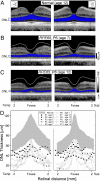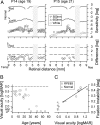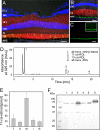Human cone photoreceptor dependence on RPE65 isomerase
- PMID: 17848510
- PMCID: PMC1986623
- DOI: 10.1073/pnas.0706367104
Human cone photoreceptor dependence on RPE65 isomerase
Abstract
The visual (retinoid) cycle, the enzymatic pathway that regenerates chromophore after light absorption, is located primarily in the retinal pigment epithelium (RPE) and is essential for rod photoreceptor survival. Whether this pathway also is essential for cone photoreceptor survival is unknown, and there are no data from man or monkey to address this question. The visual cycle is naturally disrupted in humans with Leber congenital amaurosis (LCA), which is caused by mutations in RPE65, the gene that encodes the retinoid isomerase. We investigated such patients over a wide age range (3-52 years) for effects on the cone-rich human fovea. In vivo microscopy of the fovea showed that, even at the youngest ages, patients with RPE65-LCA exhibited cone photoreceptor loss. This loss was incomplete, however, and residual cone photoreceptor structure and function persisted for decades. Basic questions about localization of RPE65 and isomerase activity in the primate eye were addressed by examining normal macaque. RPE65 was definitively localized by immunocytochemistry to the central RPE and, by immunoblotting, appeared to concentrate in the central retina. The central retinal RPE layer also showed a 4-fold higher retinoid isomerase activity than more peripheral RPE. Early cone photoreceptor losses in RPE65-LCA suggest that robust RPE65-based visual chromophore production is important for cones; the residual retained cone structure and function support the speculation that alternative pathways are critical for cone photoreceptor survival.
Conflict of interest statement
The authors declare no conflict of interest.
Figures




References
Publication types
MeSH terms
Substances
Grants and funding
LinkOut - more resources
Full Text Sources
Medical
Molecular Biology Databases
Research Materials

